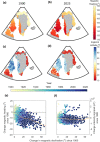Gauge-and-compass migration: inherited magnetic headings and signposts can adapt to changing geomagnetic landscapes
- PMID: 37408064
- PMCID: PMC10320893
- DOI: 10.1186/s40462-023-00406-0
Gauge-and-compass migration: inherited magnetic headings and signposts can adapt to changing geomagnetic landscapes
Abstract
Background: For many migratory species, inexperienced (naïve) individuals reach remote non-breeding areas independently using one or more inherited compass headings and, potentially, magnetic signposts to gauge where to switch between compass headings. Inherited magnetic-based migration has not yet been assessed as a population-level process, particularly across strong geomagnetic gradients or where long-term geomagnetic shifts (hereafter, secular variation) could create mismatches with magnetic headings. Therefore, it remains unclear whether inherited magnetic headings and signposts could potentially adapt to secular variation under natural selection.
Methods: To address these unknowns, we modelled migratory orientation programs using an evolutionary algorithm incorporating global geomagnetic data (1900-2023). Modelled population mixing incorporated both natal dispersal and trans-generational inheritance of magnetic headings and signposts, including intrinsic (stochastic) variability in inheritance. Using the model, we assessed robustness of trans-hemispheric migration of a migratory songbird whose Nearctic breeding grounds have undergone rapid secular variation (mean 34° clockwise drift in declination, 1900-2023), and which travels across strong geomagnetic gradients via Europe to Africa.
Results: Model-evolved magnetic-signposted migration was overall successful throughout the 124-year period, with 60-90% mean successful arrival across a broad range in plausible precision in compass headings and gauging signposts. Signposted migration reduced trans-Atlantic flight distances and was up to twice as successful compared with non-signposted migration. Magnetic headings shifted plastically in response to the secular variation (mean 16°-17° among orientation programs), whereas signpost latitudes were more constrained (3°-5° mean shifts). This plasticity required intrinsic variability in inheritance (model-evolved σ ≈ 2.6° standard error), preventing clockwise secular drift from causing unsustainable open-ocean flights.
Conclusions: Our study supports the potential long-term viability of inherited magnetic migratory headings and signposts, and illustrates more generally how inherited migratory orientation programs can both mediate and constrain evolution of routes, in response to global environmental change.
Keywords: Animal migration; Bet-hedging; Evolutionary strategy algorithm; Geomagnetic core field; Magnetic compass; Migratory orientation program; Natal dispersal; Northern wheatear; Secular variation; Zugknick.
© 2023. The Author(s).
Conflict of interest statement
The authors declare no competing interests.
Figures






Similar articles
-
Predicting performance of naïve migratory animals, from many wrongs to self-correction.Commun Biol. 2022 Oct 4;5(1):1058. doi: 10.1038/s42003-022-03995-5. Commun Biol. 2022. PMID: 36195660 Free PMC article.
-
Feasibility of sun and magnetic compass mechanisms in avian long-distance migration.Mov Ecol. 2018 Jun 6;6:8. doi: 10.1186/s40462-018-0126-4. eCollection 2018. Mov Ecol. 2018. PMID: 29992024 Free PMC article. Review.
-
Lack of evidence for a fine-scale magnetic map sense for fall migratory Eastern North American monarch butterflies (Danaus plexippus).Ecol Evol. 2022 Nov 16;12(11):e9498. doi: 10.1002/ece3.9498. eCollection 2022 Nov. Ecol Evol. 2022. PMID: 36407908 Free PMC article.
-
Bird orientation at high latitudes: flight routes between Siberia and North America across the Arctic Ocean.Proc Biol Sci. 1999 Dec 22;266(1437):2499-505. doi: 10.1098/rspb.1999.0952. Proc Biol Sci. 1999. PMID: 10693821 Free PMC article.
-
Calibration of magnetic and celestial compass cues in migratory birds--a review of cue-conflict experiments.J Exp Biol. 2006 Jan;209(Pt 1):2-17. doi: 10.1242/jeb.01960. J Exp Biol. 2006. PMID: 16354773 Review.
Cited by
-
A new data-driven paradigm for the study of avian migratory navigation.Mov Ecol. 2025 Mar 11;13(1):16. doi: 10.1186/s40462-025-00543-8. Mov Ecol. 2025. PMID: 40069784 Free PMC article. Review.
-
Extremely low frequency magnetic field distracts zebrafish from a visual cognitive task.Sci Rep. 2025 Mar 12;15(1):8589. doi: 10.1038/s41598-025-90194-x. Sci Rep. 2025. PMID: 40074776 Free PMC article.
References
Grants and funding
LinkOut - more resources
Full Text Sources

